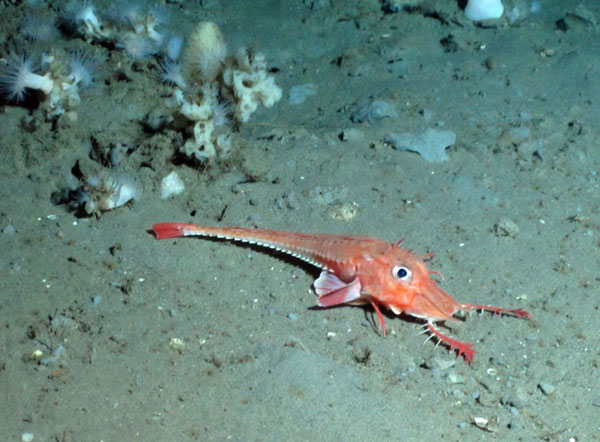Deep-Sea Stroll: This Fish 'Walks' on the Ocean Floor

Meet the sea robin, a deep-sea fish that can walk across the ocean floor.
Sea robins, or Triglidae, look nothing like their avian namesakes, other than having an orange hue. The armored type of these bottom-feeding fish have bony plates along their bodies and branched barbels (whiskers) with taste buds in front of their mouths. But it's the sea robins' thickened, stiff fin rays that make these creatures stand out.
Scientists aboard the National Oceanic and Atmospheric Administration's research ship, the Okeanos Explorer, recently captured video footage of an armored sea robin using its fin rays to "walk" along the bottom of the ocean. [In Photos: Spooky Deep-Sea Creatures]
"Those things that you see under the fish that are like little, thin legs — they're actually part of the fin," a researcher aboard the Okeanos Explorer said in the video. "They're a really interesting fish with a lot of morphological features for life on the seafloor."
Rather than swimming as other fish do, sea robins "walk" as their typical mode of transportation, Okeanos Explorer researchers explained in a dive log about the video.
Video of the fish's deep-sea stroll was captured during a dive with a remotely operated vehicle (ROV) at the Ta'u Unit of the National Marine Sanctuary of American Samoa. Okeanos is currently on a mission through April to explore the waters around American Samoa and Samoa. The expedition is part of a three-year campaign to study the sanctuary and the Rose Atoll Marine National Monument in the Pacific Ocean, in order to build scientific knowledge of the areas for better ecological support and management decisions.
"Very little is known about deep-sea habitats, including deep-sea coral and sponge communities, in American Samoa," Okeanos Explorer scientists wrote in their mission plan. "Data and information from our expedition will fill gaps in knowledge about the deep-sea habitats in the region and improve our overall understanding of the deep-sea biogeography of the Central Pacific."
Sign up for the Live Science daily newsletter now
Get the world’s most fascinating discoveries delivered straight to your inbox.
As the research ship continues to explore the American Samoa and Samoa region, you can watch live streaming videos of the researchers' dives and other footage on the Okeanos Explorer website.
Original article on Live Science.










